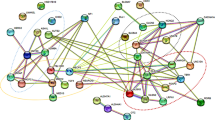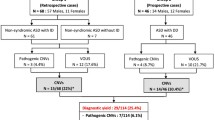Abstract
Background
Copy number variants (CNVs) play a key role in the etiology of autism spectrum disorder (ASD). Therefore, recent guidelines recommend chromosomal microarrays (CMAs) as first-tier genetic tests. This study’s first aim was to determine the clinical usefulness of CMAs in children diagnosed with ASD in a Turkish population. The second aim was to describe the CNVs and clinical phenotypes of children with ASD.
Methods and Results
This was a single-center retrospective cross‐sectional study. Data were obtained from the medical records of children with ASD followed at Gazi University Hospital, (Ankara, Turkey). The sample consisted of 47 ASD cases (mean age: 60.34 ± 25.60 months; 82.9% boys). The diagnostic yield of the CMAs was 8.5%. Four pathogenic CNVs were identified: 9p24.3p24.2 deletion, 15q11–q13 duplication, 16p11.2 deletion, and 22q13.3 deletion. Also, four variants were found at 2q36.3, 10p11.21, 15q11.2, and Xp11.22, which were classified as variants of uncertain significance (VUS).
Conclusions
The TRAP12 and PARD3 genes in CNVs classified as VUS may be worth investigating for autism. The initial identification of both clinical and biological markers can facilitate monitoring, early intervention, or prevention and advance our understanding of the neurobiology underlying ASD.
Similar content being viewed by others
Data availability
The data sets used in this study can be obtained from the corresponding author upon reasonable request.
References
American Psychiatric Association (2013) Diagnostic and statistical manual of mental disorders (5th edn.). https://doi.org/10.1176/appi.books.9780890425596.
Wiśniowiecka-Kowalnik B, Nowakowska BA (2019) Genetics and epigenetics of autism spectrum disorder: current evidence in the field. J Appl Genet. https://doi.org/10.1007/s13353-018-00480-w
Maenner MJ, Shaw KA, Baio J, et al. (2020) Prevalence of autism spectrum disorder among children aged 8 years—autism and developmental disabilities monitoring network, 11 sites, United States, 2016. MMWR Surveill. http://dx.doi.org/https://doi.org/10.15585/mmwr.ss6904a1
Vicari S, Napoli E, Cordeddu V et al (2019) Copy number variants in autism spectrum disorders. Prog Neuropsychopharmacol Biol Psychiatry 92:421–427. https://doi.org/10.1016/j.pnpbp.2019.02.012
Takumi T, Tamada K (2018) CNV biology in neurodevelopmental disorders. Curr Opin Neurobiol 48:183–192. https://doi.org/10.1016/j.conb.2017.12.004
Huguet G, Bourgeron T (2013) The genetic landscapes of autism spectrum disorders. Annu Rev Genomics Hum Genet 14:191–213. https://doi.org/10.1146/annurev-genom-091212-153431
Hyman SL, Levy SE, Myers SM (2020) Identification, evaluation, and management of children with autism spectrum disorder. Pediatrics. https://doi.org/10.1542/peds.2019-3447
Miller DT, Adam MP, Aradhya S et al (2010) Consensus statement: chromosomal microarray is a first-tier clinical diagnostic test for individuals with developmental disabilities or congenital anomalies. Am J Hum Genet 86(5):749–764. https://doi.org/10.1016/j.ajhg.2010.04.006
Carter MT, Scherer SW (2013) Autism spectrum disorder in the genetics clinic: a review. Clin Genet 83(5):399–407. https://doi.org/10.1111/cge.12101
Luo R, Sanders SJ, Tian Y et al (2012) Genome-wide transcriptome profiling reveals the functional impact of rare de novo and recurrent CNVs in autism spectrum disorders. Am J Hum Genet 91(1):38–55. https://doi.org/10.1016/j.ajhg.2012.05.011
Woodbury-Smith M, Scherer SW (2018) Progress in the genetics of autism spectrum disorder. Dev Med Child Neurol 60(5):445–451. https://doi.org/10.1111/dmcn.13717
Sucuoglu B, Oktem F, Akkok F, Gokler B (1996) A study of the scales for the assessment of the children with autism. Psikiyatri Psikoloji Psikofarmakoloji 3P(4):116–121
Savasir I, Sezgin N, Erol N (1994) Handbook of Ankara developmental screening inventory. Turkish Psychologists Association Publication, Ankara
Savaşır I, Şahin N (1995) Wechsler çocuklar için zeka ölçeği (WISC-R) el kitabı. Türk Psikologlar Derneği Yayınları, Ankara
Riggs ER, Andersen EF, Cherry AM et al (2020) Technical standards for the interpretation and reporting of constitutional copy-number variants: a joint consensus recommendation of the American College of Medical Genetics and Genomics (ACMG) and the Clinical Genome Resource (ClinGen). Genet Med 22(2):245–257. https://doi.org/10.1038/s41436-019-0686-8
Capkova P, Srovnal J, Capkova Z et al (2019) MLPA is a practical and complementary alternative to CMA for diagnostic testing in patients with autism spectrum disorders and identifying new candidate CNVs associated with autism. PeerJ. https://doi.org/10.7717/peerj.6183
Xiong J, Chen S, Pang N et al (2019) Neurological diseases with autism spectrum disorder: role of ASD risk genes. Front Neurosci 13:349. https://doi.org/10.3389/fnins.2019.00349
Harris HK, Nakayama T, Lai J et al (2021) Disruption of RFX family transcription factors causes autism, attention-deficit/hyperactivity disorder, intellectual disability, and dysregulated behavior. Genet Med 23:1028–1040. https://doi.org/10.1038/s41436-021-01114-z
Vanzo RJ, Martin MM, Sdano MR, South ST (2013) Familial KANK1 deletion that does not follow expected imprinting pattern. Eur J Med Genet 56(5):256–259. https://doi.org/10.1016/j.ejmg.2013.02.006
Benítez-Burraco A, Fernández-Urquiza M, Jiménez-Romero MS (2020) Language impairment with a partial duplication of DOCK8. Mol Syndromol 11(5–6):243–263. https://doi.org/10.1159/000511972
Guffanti G, Strik Lievers L, Bonati MT et al (2011) Role of UBE3A and ATP10A genes in autism susceptibility region 15q11-q13 in an Italian population: a positive replication for UBE3A. Psychiatry Res 185(1–2):33–38. https://doi.org/10.1016/j.psychres.2010.04.057
Sledziowska M, Galloway J, Baudouin J (2020) Evidence for a contribution of the Nlgn3/Cyfip1/Fmr1 pathway in the pathophysiology of autism spectrum disorders. Neuroscience 445:31–41. https://doi.org/10.1016/j.neuroscience.2019.10.011
Al Ageeli E, Drunat S, Delanoë C et al (2014) Duplication of the 15q11-q13 region: clinical and genetic study of 30 new cases. Eur J Med Genet 57(1):5–14. https://doi.org/10.1016/j.ejmg.2013.10.008
Buxbaum JD, Silverman JM, Smith CJ et al (2002) Association between a GABRB3 polymorphism and autism. Mol Psychiatry 7(3):311–316. https://doi.org/10.1038/sj.mp.4001011
Depienne C, Moreno-De-Luca D, Heron D et al (2009) Screening for genomic rearrangements and methylation abnormalities of the 15q11-q13 region in autism spectrum disorders. Biol Psychiatry 66(4):349–359. https://doi.org/10.1016/j.biopsych.2009.01.025
Wisniewski L, Hassold T, Heffelfinger J, Higgins JV (1979) Cytogenetic and clinical studies in five cases of inv dup(15). Hum Genet 50(3):259–270. https://doi.org/10.1007/BF00399391
Miller DT, Chung W, Nasir R et al (2009) 16p11.2 recurrent microdeletion. [Updated 2015 Dec 10]. In: Adam MP, Ardinger HH, Pagon RA et al (eds) GeneReviews® [Internet]. University of Washington, Seattle, Seattle (WA)
Niarchou M, Chawner SJRA, Doherty JL et al (2019) Psychiatric disorders in children with 16p112 deletion and duplication. Transl Psychiatry 9(1):8. https://doi.org/10.1038/s41398-018-0339-8
Rein B, Yan Z (2020) 16p11.2 copy number variations and neurodevelopmental disorders. Trends Neurosci 43(11):886–901. https://doi.org/10.1016/j.tins.2020.09.001
Jacquemont S, Reymond A, Zufferey F et al (2011) Mirror extreme BMI phenotypes associated with gene dosage at the chromosome 16p11.2 locus. Nature 478(7367):97–102. https://doi.org/10.1038/nature10406
Qureshi AY, Mueller S, Snyder AZ et al (2014) Opposing brain differences in 16p11.2 deletion and duplication carriers. J Neurosci 34:11199–11211. https://doi.org/10.1523/JNEUROSCI.1366-14.2014
De Rubeis S, Siper PM, Durkin A et al (2018) Delineation of the genetic and clinical spectrum of Phelan-McDermid syndrome caused by SHANK3 point mutations. Mol Autism 9:31. https://doi.org/10.1186/s13229-018-0205-9
O’Roak BJ, Stessman HA, Boyle EA et al (2014) Recurrent de novo mutations implicate novel genes underlying simplex autism risk. Nat Commun 5:5595. https://doi.org/10.1038/ncomms6595
Bramswig NC, Lüdecke HJ, Pettersson M et al (2017) Identification of new TRIP12 variants and detailed clinical evaluation of individuals with non-syndromic intellectual disability with or without autism. Hum Genet 136(2):179–192. https://doi.org/10.1007/s00439-016-1743-x
Zhang J, Gambin T, Yuan B et al (2017) Haploinsufficiency of the E3 ubiquitin-protein ligase gene TRIP12 causes intellectual disability with or without autism spectrum disorders, speech delay, and dysmorphic features. Hum Genet 136(4):377–386. https://doi.org/10.1007/s00439-017-1763-1
Donoghue T, Garrity L, Ziolkowski A, McPhillips M, Buckman M, Goel H (2020) Novel de novo TRIP12 mutation reveals variable phenotypic presentation while emphasizing core features of TRIP12 variations. Am J Med Genet Part A 182A:1801–1806. https://doi.org/10.1002/ajmg.a.61618
Shi SH, Jan LY, Jan YN (2003) Hippocampal neuronal polarity specified by spatially localized mPar3/mPar6 and PI 3-kinase activity. Cell 112(1):63–75. https://doi.org/10.1016/s0092-8674(02)01249-7
Hakanen J, Ruiz-Reig N, Tissir F (2019) Linking cell polarity to cortical development and malformations. Front Cell Neurosci 13:244. https://doi.org/10.3389/fncel.2019.00244
Sterling N, Duncan AR, Park R et al (2020) De novo variants in MPP5 cause global developmental delay and behavioral changes. Hum Mol Genet 29(20):3388–3401. https://doi.org/10.1093/hmg/ddaa224
Paul LK, Brown WS, Adolphs R et al (2007) Agenesis of the corpus callosum: genetic, developmental and functional aspects of connectivity. Nat Rev Neurosci 8(4):287–299. https://doi.org/10.1038/nrn2107
Wegiel J, Flory M, Kaczmarski W et al (2017) Partial Agenesis and Hypoplasia of the Corpus Callosum in Idiopathic Autism. J Neuropathol Exp Neurol 76(3):225–237. https://doi.org/10.1093/jnen/nlx003
Steinman KJ, Spence SJ, Ramocki MB et al (2016) 16p112 deletion and duplication: characterizing neurologic phenotypes in a large clinically ascertained cohort. Am J Med Genet A 170(11):2943–2955. https://doi.org/10.1002/ajmg.a.37820
Liu WA, Chen S, Li Z et al (2018) PARD3 dysfunction in conjunction with dynamic HIPPO signaling drives cortical enlargement with massive heterotopia. Genes Dev 32(11–12):763–780. https://doi.org/10.1101/gad.313171.118
Chen CH, Chen HI, Chien WH et al (2017) High resolution analysis of rare copy number variants in patients with autism spectrum disorder from Taiwan. Sci Rep. https://doi.org/10.1038/s41598-017-12081-4
Kosmicki JA, Samocha KE, Howrigan DP et al (2017) Refining the role of de novo protein-truncating variants in neurodevelopmental disorders by using population reference samples. Nat Genet 49(4):504–510. https://doi.org/10.1038/ng.3789
Picinelli C, Lintas C, Piras IS et al (2016) Recurrent 15q112 BP1-BP2 microdeletions and microduplications in the etiology of neurodevelopmental disorders. Am J Med Genet B 171(8):1088–1098. https://doi.org/10.1002/ajmg.b.32480
Lusk L, Vogel-Farley V, DiStefano C, Jeste S et al (2016) Maternal 15q duplication syndrome. In: Adam MP et al (eds) GeneReviews®. University of Washington, Seattle
Evers C, Mitter D, Strobl-Wildemann G et al (2015) Duplication Xp1122-p14 in females: does X-inactivation help in assessing their significance? Am J Med Genet A 167A(3):553–562. https://doi.org/10.1002/ajmg.a.36897
Froyen G, Van Esch H, Bauters M et al (2007) Detection of genomic copy number changes in patients with idiopathic mental retardation by high-resolution X-array-CGH: important role for increased gene dosage of XLMR genes. Hum Mutat 28(10):1034–1042. https://doi.org/10.1002/humu.20564
Acknowledgements
We would like to thank the children and their families who participated in this study.
Funding
The authors did not receive support from any organization for the submitted work.
Author information
Authors and Affiliations
Contributions
Conceptualization: Eİ, FEP, MAE, EG. Data acquisition: AÖ, Eİ, EG. Formal analysis: AÖ, GK; Writing—original draft preparation: AÖ; Writing—review and editing: AÖ, GK, Eİ, MAE, EG, FEP. Supervision: Eİ, MAE, EG, FEP.
Corresponding author
Ethics declarations
Conflicts of interest
The authors have no conflicts of interest to declare that are relevant to the content of this article.
Consent to participate
Informed consent was obtained from all participants included in the study.
Ethical approval
This study was approved by the Clinical Research Ethics Committee of Gazi University’s Faculty of Medicine (No. 431).
Additional information
Publisher's Note
Springer Nature remains neutral with regard to jurisdictional claims in published maps and institutional affiliations.
Rights and permissions
About this article
Cite this article
Özaslan, A., Kayhan, G., İşeri, E. et al. Identification of copy number variants in children and adolescents with autism spectrum disorder: a study from Turkey. Mol Biol Rep 48, 7371–7378 (2021). https://doi.org/10.1007/s11033-021-06745-8
Received:
Accepted:
Published:
Issue Date:
DOI: https://doi.org/10.1007/s11033-021-06745-8




